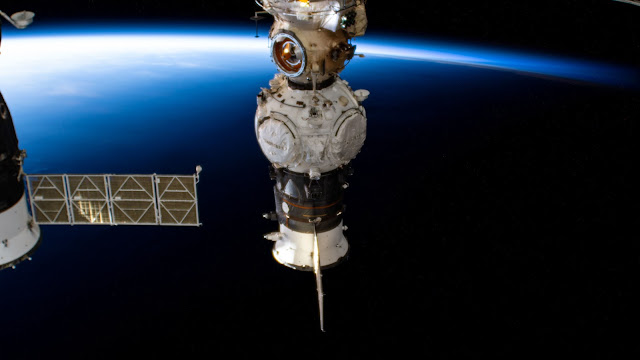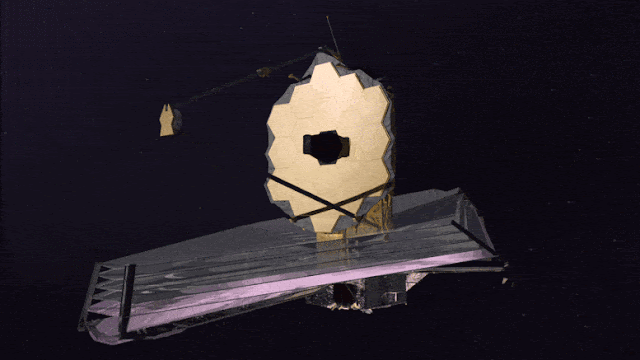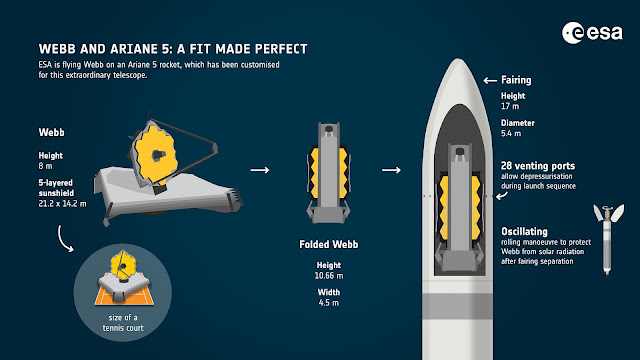NASA - Hubble Space Telescope patch.
Dec 28, 2021
Far above rain clouds, light pollution, and atmospheric distortion, NASA’s Hubble Space Telescope has a clear view of the universe. It has shown us distant galaxies, tracked interstellar objects as they soar through our solar system, and studied the atmospheres of planets that orbit other stars. In addition to its own stunning images and groundbreaking discoveries, Hubble uses its powerful vision to support many other past, ongoing, and future missions in space.
Hubble Space Telescope (HST). Image Credit: NASA
These missions represent a vast array of science – from planetary probes that get up close to study the intricate dynamics of the gas giants’ atmospheres, to observatories that look beyond our solar system into deep space to study the early universe.

Image above: The James Webb Space Telescope is expected to launch on December 24, 2021.
Image Credits: NASA/GSFC.
An upcoming key example of support for such missions is Hubble’s preparatory observations for NASA's James Webb Space Telescope, a partnership with the European Space Agency and Canadian Space Agency, set to launch on December 24. Built to advance science goals motivated by Hubble’s discoveries, Webb will have a head start on its mission to learn more about the oldest galaxies in our cosmos, mysterious planets beyond other stars, and much more. This type of mission collaboration has been an important part of Hubble’s legacy.
Uncovering Our Solar System
Hubble has supported several of NASA’s most important and compelling planetary missions. The science and images gathered from these missions have not only allowed us to further our understanding of our outer solar system but also provide us with a closer look.
Hubble’s observations of Jupiter have assisted several missions studying the atmosphere, moons, and cosmic objects surrounding the gas giant. Monitoring activity in Jupiter’s atmosphere for decades, Hubble has seen massive storms burst forward from beneath the clouds, and watched its largest storm, the Great Red Spot, shrink as its wind speeds increase. Following up on these observations and working in tandem with Hubble, the Juno mission has continued to learn more about these cloud layers and what makes the storms stir.
The New Horizons mission used Hubble observations to learn more about its target, the dwarf planet Pluto. Hubble discovered four additional Plutonian moons from its observations, two of which were found after New Horizons launched. Without Hubble’s help, New Horizons would have discovered the tiny moons only a few months before its visit to Pluto, allowing for little time to properly plan all of the new observations. In June 2014, Hubble searched for and discovered another target for the New Horizons spacecraft, 2014 MU69, now called Arrokoth, the farthest and most primitive solar system object ever explored by humankind. New Horizons flew by Arrokoth in early 2019.
Hubble will help study the compositional components of the Trojan asteroids in support of NASA’s Lucy mission, which launched in October 2021. These asteroids orbit the Sun in tandem with Jupiter and are thought to be left over from the formation of the solar system. Because Hubble can detect a small, dim satellite orbiting a larger asteroid – something an Earth-bound telescope might miss – the Lucy team is using Hubble to search for Trojan satellites prior to Lucy’s launch. They made their first round of observations in the fall of 2018.
The next year they spotted something that might have been a satellite near Eurybates, a Trojan asteroid, and submitted an urgent proposal to use Hubble again. They were able to get their observations about a month later. Hubble discovered that Eurybates has a small satellite, subsequently named Queta. This discovery has become a “bonus” science exploration opportunity for the spacecraft as it will be visiting not seven but eight asteroids, targeted for a flyby in 2027.
Though searching for satellites is one of the mission’s central goals, finding these tiny worlds before Lucy launched gives the team the opportunity to investigate their orbits and plan for more detailed follow-up observations with the spacecraft.
Exoplanets, Stars, Galaxies, and More
When Hubble launched over 30 years ago, astronomers had no way to prove that planets existed outside our solar system.
Today, thousands of exoplanets are known to exist. Hubble currently works alongside other space telescopes like TESS, the Transiting Exoplanet Survey Satellite, which aims to find promising exoplanets orbiting our nearest and brightest stars. Hubble supports these TESS discoveries by obtaining ultraviolet spectra of the exoplanets’ host stars to establish how radiation from stars affects their exoplanets’ atmospheric chemistry and composition. Hubble also collects measurements of exoplanet atmospheres to search for evidence of clouds, hazes, and/or water.
Among many other goals, the James Webb Space Telescope will observe exoplanets where Hubble provided a confident detection of water in the atmosphere and measure its abundance.
Hubble is also supporting Webb through a series of preparatory science observations to identify potential targets for the telescope. Started in 2016, the program encourages astronomers to submit science proposals for Hubble observations to pave the way for Webb’s observations. Once launched, the telescope will be able to immediately start probing deeper into stellar populations and building upon observations of galaxies and their forms.
Recently, Hubble had its eye on a relic galaxy, NGC 1277, whose stars were born 10 billion years ago – but it has undergone no further star formation. Galaxies like NGC 1277 are called “red and dead,” and are typically too far away to be studied in detail. Webb will be able to measure the motions of the globular star clusters in NGC 1277 and potentially learn more about the dark matter it contains, providing new insight into this type of galaxy.
NASA's Roman Space Telescope, set to launch in the mid-2020s, will observe many objects Hubble or Webb already studied. It won't focus on a single object, but rather build upon the large mosaics taken by Hubble due to Roman’s large field of view and detectors. One example is the PHAT mosaic which covers a third of the Andromeda Galaxy and was created with over 400 Hubble images. Roman will capture this view in infrared light using only two images, opening a world of understanding about galaxies and their components.
The Future of Astronomy in Deep Space
The COSMOS survey began in 2002 as a Hubble program to image a wide and deep patch of sky, about the area of 10 full moons. Once Webb begins science observations in the summer of 2022, it will build on that legacy by surveying a half-million galaxies within that patch of sky, becoming the largest project Webb will undertake during its first year. Called COSMOS-Webb, this in-depth survey will allow scientists to learn more about dark matter and how it has evolved with galaxies and their stars over the universe’s lifetime.

Hubble Space Telescope (HST). Animation Credits: NASA/ESA
Gravitational waves are 'ripples' in space-time caused by some of the most violent and energetic processes in the universe; these disturbances can be picked up with ground-based detectors like the Laser Interferometer Gravitational-Wave Observatory, which is funded by the National Science Foundation and operated by Caltech and MIT. Because signals from a gravitational wave only give astronomers a very brief signal of spacetime disturbance without much directional information, astronomers then use telescopes that can be pointed very quickly across the sky and cover a vast area to hone in on the region of space where the signals originated. Gravity waves and light waves are physically different ways to transmit information, and observations using both are called multi-messenger astronomy, a rapidly growing field of astronomy.
James Webb Space Telescope (JWST). Animation Credits: NASA/ESA
Once astronomers have found the right galaxy where the cosmic event, such as the merging of two dense neutron stars, has occurred; Hubble is then focused on that area. Hubble can obtain a detailed spectrum of light and a sharp image of the galaxy to better understand the event, detecting radiation that is sometimes associated with the event producing gravitational waves. Once launched, Webb will also be used for in-depth study of these events.
Over its lifetime, Hubble’s powerful vision has “set the stage” for Webb and several other missions that aim to uncover fascinating facts about our universe – from our cosmic neighborhood to the farthest reaches of space.
Related links:
James Webb Space Telescope (JWST): https://jwst.nasa.gov/content/webbLaunch/index.html
Hubble Space Telescope (HST): https://www.nasa.gov/mission_pages/hubble/main/index.html
Images (mentioned), Animations (mentioned), Text, Credits: NASA/Andrea Gianopoulos/GSFC/Claire Andreoli.
Greetings, Orbiter.ch




















































